Belmont vortex: Vision vs. reality in Belmont Bridge debate
-
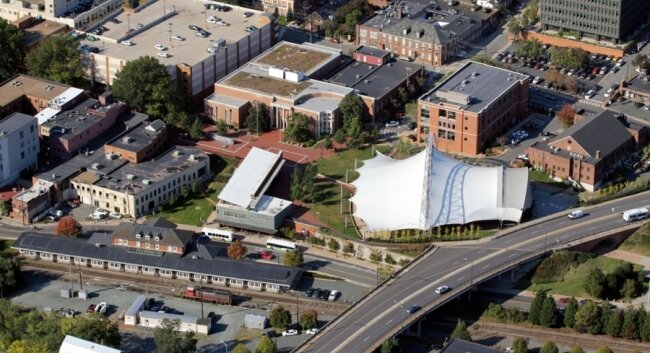 Steve Trumbull
Steve Trumbull -
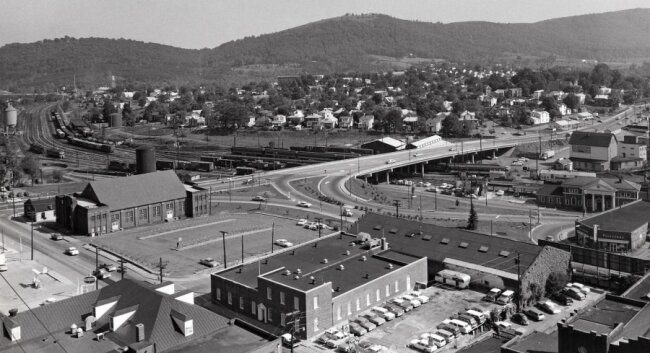 Downtown gateway or bypass? The Belmont Bridge seen here in the early 1960s. Notice the size of the rail yard beneath it and the on and off ramps that connect with East Main Street and Water Street.Ed Roseberry
Downtown gateway or bypass? The Belmont Bridge seen here in the early 1960s. Notice the size of the rail yard beneath it and the on and off ramps that connect with East Main Street and Water Street.Ed Roseberry -
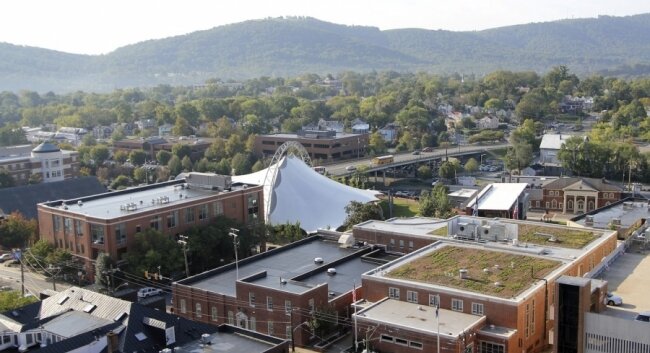 That same view of the bridge area today, which bypasses the downtown entirely and passes over a much smaller rail yard.Steve Trumbull
That same view of the bridge area today, which bypasses the downtown entirely and passes over a much smaller rail yard.Steve Trumbull -
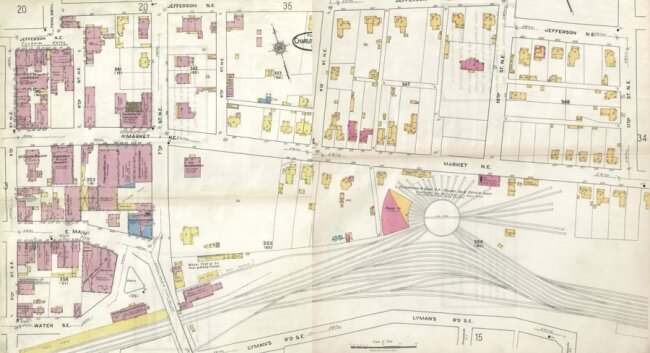 Historical perspective: this circa-1920 map of Charlottesville shows how Monticello Road flowed into downtown.Sanborn Maps
Historical perspective: this circa-1920 map of Charlottesville shows how Monticello Road flowed into downtown.Sanborn Maps -
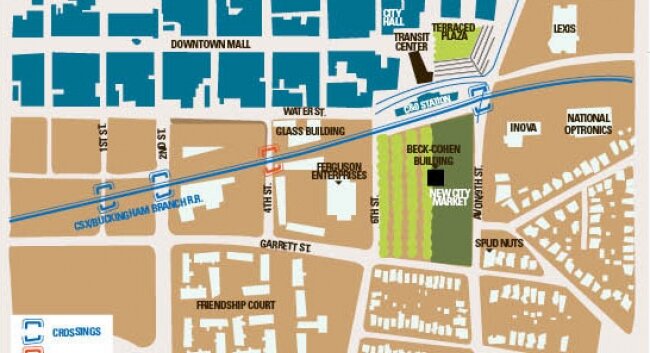 Belmont UnAbridged, the winning design from a team of UVA Architecture School students and faculty, calls for the removal of the Belmont Bridge.UVA Team 18/Simplified by Hook Staff
Belmont UnAbridged, the winning design from a team of UVA Architecture School students and faculty, calls for the removal of the Belmont Bridge.UVA Team 18/Simplified by Hook Staff -
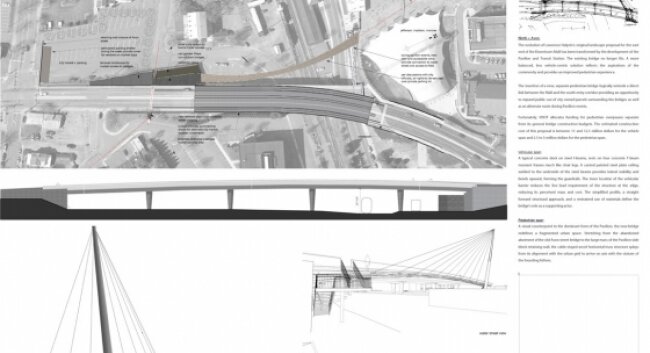 Ninth & Avon, the second-place winner from local architect Jim Rounsevell.jim rounsevell
Ninth & Avon, the second-place winner from local architect Jim Rounsevell.jim rounsevell -
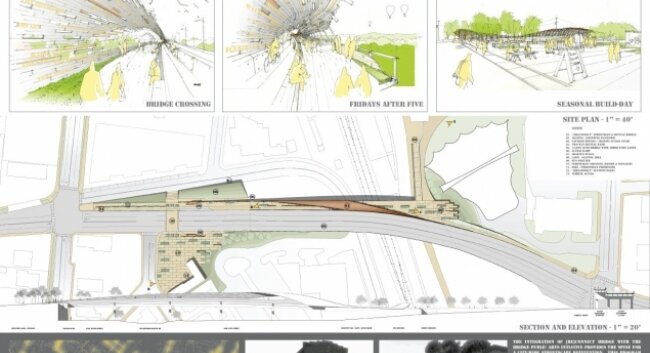 (Re)Connect Charlottesville, the third-place winner by Daniel LaRossa and Amadeo Bennetta.daniel larossa & amadeo bennetta
(Re)Connect Charlottesville, the third-place winner by Daniel LaRossa and Amadeo Bennetta.daniel larossa & amadeo bennetta -
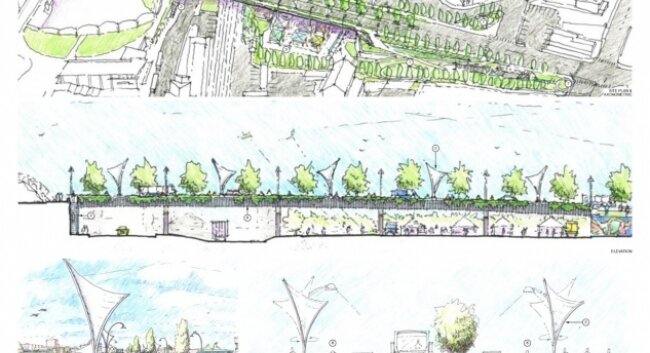 The Belmont Bridge, by Tim Tessier, received an honorable mention.tim tessier
The Belmont Bridge, by Tim Tessier, received an honorable mention.tim tessier -
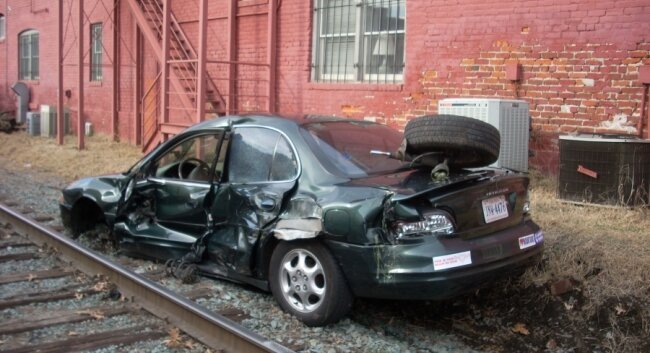 Are at-grade crossings safe? The driver of this car luckily walked away after a rendezvous with Amtrak's Cardinal at a downtown crossing in 2008.Jen Fariello
Are at-grade crossings safe? The driver of this car luckily walked away after a rendezvous with Amtrak's Cardinal at a downtown crossing in 2008.Jen Fariello -
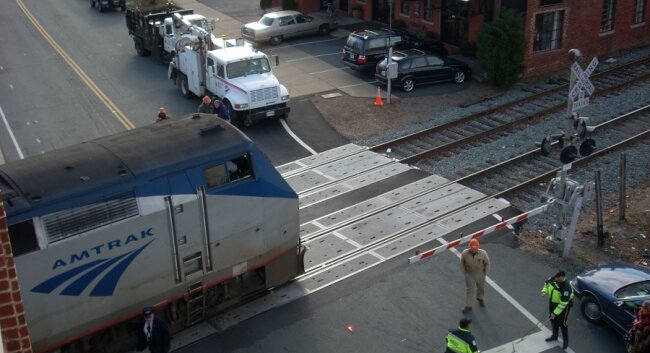 Amtrak and rail advocates have been pushing hard to run the Cardinal through Charlottesville seven days a week.Jen Fariello
Amtrak and rail advocates have been pushing hard to run the Cardinal through Charlottesville seven days a week.Jen Fariello -
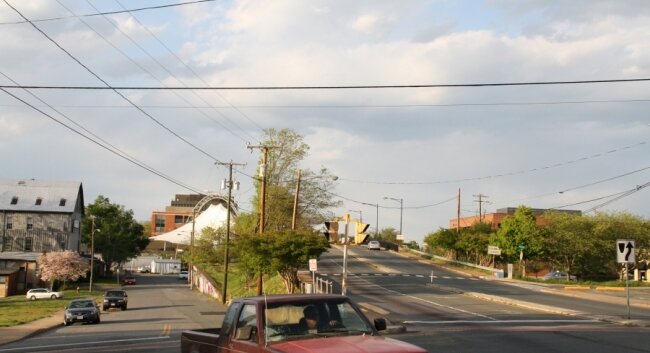 Separately, the City is spending $150,000 to study redevelopment including the area to the west (left side in photo) of the bridge.hawes spencer
Separately, the City is spending $150,000 to study redevelopment including the area to the west (left side in photo) of the bridge.hawes spencer -
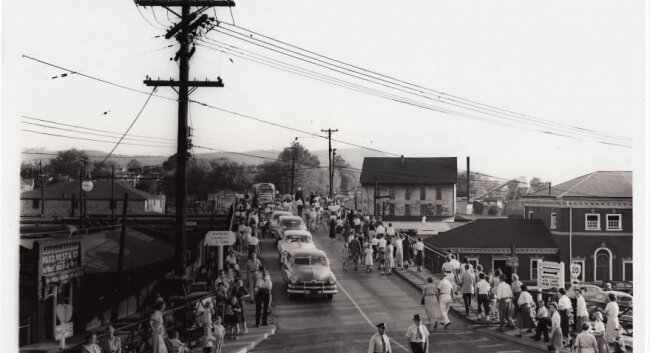 Built in 1905 and seen here on a parade day in 1951, a smaller bridge once spanned the tracks.Edwin Roseberry
Built in 1905 and seen here on a parade day in 1951, a smaller bridge once spanned the tracks.Edwin Roseberry -
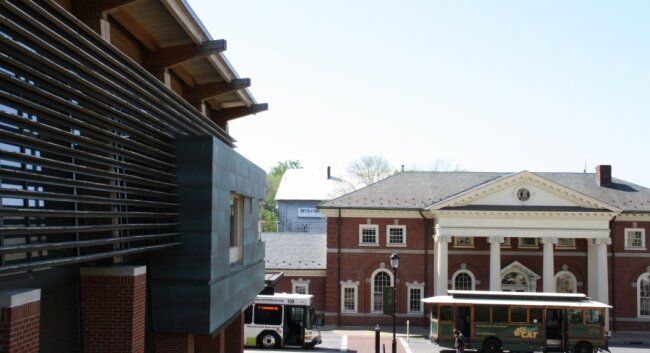 New roads, such as an extended Water Street, and new buildings, such as the Charlottesville Transit Center, now fill the scene.Hawes Spencer
New roads, such as an extended Water Street, and new buildings, such as the Charlottesville Transit Center, now fill the scene.Hawes Spencer -
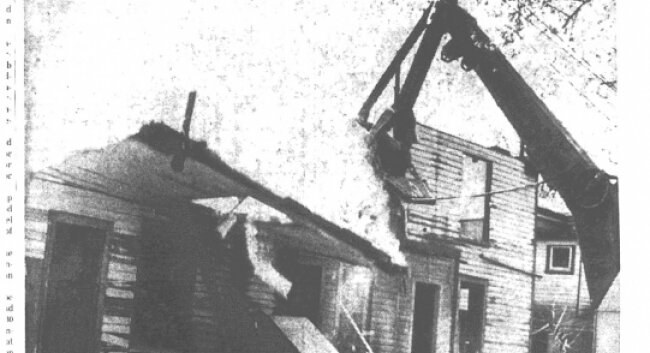 The City spent $585,000 to acquire 30 parcels to make room for the 1961 bridge.Daily Progress
The City spent $585,000 to acquire 30 parcels to make room for the 1961 bridge.Daily Progress -
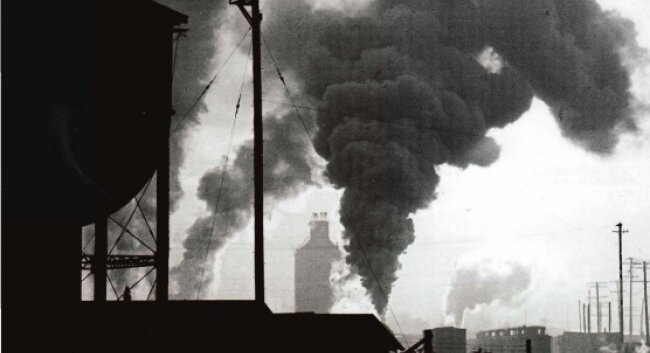 The C&O once had a massive rail yard stretching east from the bridge. In the early 1990s, it was largely converted to an office park.edwin roseberry
The C&O once had a massive rail yard stretching east from the bridge. In the early 1990s, it was largely converted to an office park.edwin roseberry -
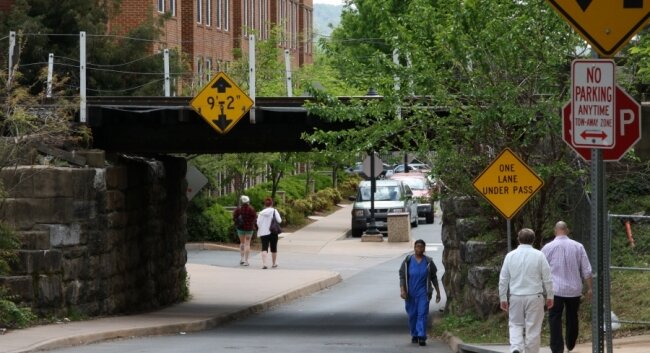 To help make "Belmont unAbridged" work, this one-lane railroad underpass on nearby 4th Street would be expanded (for an untold sum).hawes spencer
To help make "Belmont unAbridged" work, this one-lane railroad underpass on nearby 4th Street would be expanded (for an untold sum).hawes spencer
There's a grass roots community movement calling for the re-design of the east end of the downtown area, creating a "gateway" ("Gait-Way," actually, to emphasize pedestrianism) from Belmont that would dovetail into the Downtown Mall in a less car-centric, more pedestrian-friendly way. There's just one problem: there's a big bridge in the way.
In 2003, the City determined that the circa-1961 Belmont Bridge was “rapidly deteriorating,” due to corrosion of the reinforcing steel in the bridge deck that has been weakening the concrete piers. Since then, countless hours of planning have gone into preparations for the eventual replacement of the bridge, as well as $210,000 in temporary repairs and another $714,000 to MMM Design Group, the Norfolk-based engineering and design firm that determined the bridge needed replacing, and later won the contract to design a new one. The new bridge is expected to cost $14.5 million.
Last year, replacing the Belmont Bridge was identified as the City’s number one priority for transportation projects, as they hope to secure as much as $12.8 million in state and federal funds for project. So far, the City has been allocated $6.1 million in federal-state aid. The estimated deadline for an approved design for the bridge is in late 2013, with construction beginning the following year– if the remaining funds are allocated.
Seeking community input, the City held a series of public meetings and design charrettes, and presented preliminary design plans for the new bridge last September. Citizen reaction, especially from Belmont residents, was lukewarm. Instead of another "highway-style" bridge, many expressed a desire for a less hulking expanse of roadway (the current bridge accommodates four lanes) that would provide a more pedestrian-friendly gaitway.
In January, a design contest for the new bridge was held that mobilized nearly all the faculty and staff at UVA's School of Architecture in an effort dubbed "Belmont Vortex." Led by a renowned visiting architect from Spain, the contest elicited proposals from 29 teams of students and 30 faculty members.
In the end, the jury, made up of A-School faculty and Belmont residents, selected a design that called for removing the Belmont Bridge.
Yes, you heard that right.
"We realized that the current bridge acts as a barrier and not a connector," says Kate Martin, one 15 UVA architecture grad students who worked on the winning design. "It's a giant separator between two beautiful and historic neighborhoods."
The triumphant design team envisioned an at-grade crossing over the Buckingham Branch, a freight railroad that leases the line from CSX. The design also calls for removing the nTelos Wireless Pavilion and relocating it to a vacant part of Frank Ix property along Monticello Avenue. All this would make room for a large Farmer's Market, public orchards, park space, and more mixed-use development on the old bridge easements, something more consistent with what famed designer Lawrence Halprin had in mind for that end of the Downtown Mall.
"I think it would be difficult to convince government officials that a pedestrian-centric design should be chosen instead of an automobile-centric design," says Martin.
You think? Former local journalist Rey Barry calls the idea "lunacy."
"Rather than move traffic, they want to jam it," says Barry. "Where improvement is needed, their answer is a kinky proposition based on abstractions that are fun in classrooms but ignore reality."
One government official with whom the Hook spoke wasn't as blunt but was no less critical of the no-bridge idea ultimately branding it "fanciful and unworkable."
As for relocating the Pavilion, that could be the most unworkable part of the plan because, as Pavilion manager Kirby Hutto points out, they have a lease that runs until 2034.
"I would need to revisit our lease to see if there is any language about the City asking us to move out before then," says Hutto. "But I know our attorneys did a very good job of protecting our interests throughout the lease negotiations."
Besides requiring private land for a relocated nTelos Pavilion, the design also grabs an entire city block containing private property occupied by Beck-Cohen HVAC company and other businesses and assessed at a combined $2.6 million.
So, have the A-school folks lost their marbles? Or have they offered the City a unique vision that could transform downtown for the better? Even the winning design team knew they were headed off the beaten path.
"My team every now and then would say, 'Wait, are we seriously going into this bridge competition without a bridge?'" says Martin. "But I do think that it is the best option. And I think a city like Charlottesville is just the place to take a stand on this important subject."
What about the trains?
While the ideas coming from the A-school may be innovative, how realistic are they? In their excitement over the radical no-bridge design, some supporters may have overlooked just how many vehicles use it and how many trains pass under it.
Brian Wimer, the Belmont resident and film-maker credited with spear-heading the design contest, recently penned an opinion piece in the C-Ville Weekly arguing that no bridge was needed because train traffic would decrease as did demand for coal did.
"So, let’s back-track logically: No coal … no trains … no bridge," Wimer wrote.
While it's true that domestic coal sales have fallen as utilities opt for cleaner and, sometimes, cheaper alternatives, the CSX coal export business has tripled in the past five years with CSX buying 7,000 new coal cars to better serve its coal piers in Newport News.
Steve Powell, president of the Buckingham Branch Railroad, notes that the long trains Charlottesvillians can see daily are empty CSX cars headed west to the coalfields. CSX uses them to handle overflow traffic from their James River line, which is the one all of the loaded coal trains use because it is more level and doesn't have to deal with Afton Mountain. In fact, except for times when the C&O/CSX has been repairing the James River line, there hasn't been a loaded, eastbound coal train through Charlottesville since the 1920s or 30s, when the James River line was built.
The CSX trains operate on an as-needed basis, so they have no set schedule either. On a slow day, Powell says, three CSX trains might run. On a busy day, 10 trains. On average, he says, about seven trains a day pass through Charlottesville. Buckingham Branch itself hauls freight and serves mainly local industries between Doswell/Ashland and Clifton Forge with two trips a day, one east and one west, and no set schedule.
The Buckingham Branch also has its yard beneath the Belmont Bridge, five tracks where the railroad can string cars together and perform repairs.
"There's a lot of moves to set up a train," says Powell. "Sometimes this goes on for an hour, and they pass back and forth under the bridge a dozen times."
Then there's Amtrak, which runs a passengers train called the Cardinal on the line twice a day, three times a week. However, Amtrak and rail advocates have been pushing hard to run the Cardinal seven times a week. Indeed, a big part of President Obama's transportation plan includes more passenger rail service and high speed trains. More freight trains are part of the plan too.
"There's a trend toward more rail use for freight," says Powell, both because its more efficient and greener. "For example, one rail car equals four trucks on the road. So, a 150-car train– that would be 600 trucks."
Powell also says there's been a national trend toward eliminating crossings for safety reasons. Indeed, while not alarming, according to Federal Railroad Administration data, there were 1,211 incidents at crossings that led to fatalities or injuries in 2011. Virginia, too, has rules in place to encourage the reduction of at-grade crossings.
Back in January 2008, a westbound Amtrak Cardinal struck a car at the crossing near the X Lounge, delaying traffic and 192 train passengers for 65 minutes. The driver's car was totaled, but the driver, who had a history of traffic violations, walked away. He was later cited for disregard of a railroad traffic signal.
"Getting rid of the bridge and putting an at-grade crossing there would be contrary to every effort in the country to eliminate them," says Powell.
What about the traffic?
While City Councilor Dave Norris finds the no-bridge design appealing, specifically the idea of freeing up the City land beneath it for mixed-use development, he worries about traffic.
"That road is a major in-town artery," says Norris, "and given the level of railroad activity on that line I would be reluctant to have all the other traffic clogged up every time a train comes through."
As former journalist Barry mentions, it's one of the most heavily-used auto routes over the rail line as it weaves through town, especially on the east side. According to Virginia Transportation Department data, 18,000 vehicles pass over the bridge each day. By comparison, the at-grade crossing where Meade Avenue and Carlton Road meet– which often causes traffic tie-ups– sees just 8,000 vehicles a day.
Still, not all public officials consider the no-bridge idea lunacy.
"I love the idea of no bridge," says newly elected City Councilor Dede Smith.
When she was campaigning last year, Smith says she stopped in to see Chris Gibson of Gibson's Grocery, which occupies the northeast corner of Avon Street and Hinton Avenue.
"Chris grew up in that area and remembers when there were many more trains than there are now," says Smith. "I remember him speculating at that time, 'what if there were no bridge?'"
Smith thinks the idea would open up many more attractive possibilities for redevelopment but says she recognizes the difficulty of working with the railroad.
"But then, we'll never know if we don't ask," she says.
Do we really need that bridge?
While removing the bridge might seem insane to some, some think it would be insane not to.
Daniel Bluestone, an A-School faculty advisor on the winning design, points out that the circa-1961 bridge was built at a time when there was a much larger rail yard beneath the bridge and as many as one hundred trains passing through each day.
"I think it's fanciful to think that we should be spending $14.5 million to build a highway bridge over a railroad track that has perhaps five to seven trains a day," says Bluestone, who calls the proposed highway bridge design "insane."
Today, while the current train traffic might mean a five- to seven-minute wait from time to time when the big, empty coal cars pass by, Bluestone doesn't see it as a major inconvenience that would seriously tie up traffic. Besides, he says that their design calls for signals to direct traffic to other nearby passages: the Ridge Street bridge or to a (widened) underpass at nearby Fourth Street.
While the City isn't embracing the no-bridge concept by any means (to do so would be a difficult political pill to swallow, as $1.2 million in tax dollars has already been spent planning for a bridge), City Council recently allocated $150,000 to study possible redevelopment of that part of town. In addition, a committee has been formed to look at alternative bridge designs based on the ideas that emerged from the design competition.
"We will look seriously at the designs," says neighborhood development chief Jim Tolbert, who is organizing the committee. "We will have a working group of our design team and two members of the UVA faculty to review the plans and work to see what we can incorporate."
In the meantime, the current design process is on hold, says Norris, who believes there is strong interest among at least two or three Councilors in revisiting it.
"But time will tell," he says.
Though the jury selected perhaps the most radical transfiguration for the bridge location, other prize-winning entries retained a bridge, but called for attaching a new pedestrian bridge to the Mall, using City land beneath and around the bridge for parks, gardens, pedestrian and bike ways (and even overlooks to watch the trains go by), features that would make the official "highway" style bridge more people-friendly.
Of course, any major re-thinking of the project– like simply tearing down the bridge– might put the allocation of state-federal money in jeopardy, and at the least would require the City to re-apply for transportation funds. On the other hand, not building a new bridge might allow the City to save money and re-direct those transportation funds to other projects, all while making downtown more dynamic.
"I think the point of this competition was to suggest what ought to be there," says grad student winner Martin. "The point is that things like traffic patterns can be modified to suit the community's desires. We should not limit the scope of a vision on how we can improve a place in order to accommodate traffic."
Indeed, it was the visionary and radical idea of closing off nine blocks on Main Street– arguably more disruptive to traffic flow than removing the Belmont Bridge– that gave Charlottesville its Downtown Mall, which no one now would call fanciful or lunatic– though many did at the time. What's more, sections of the Belmont Bridge have already been removed, as off ramps that flowed into Water & Main Streets were clipped– most recently in 1993 for the LexisNexis tunnel.
So, should the City simply take the free government money to build a new bridge, or embrace another bold vision for developing downtown Charlottesville?
"If the people of Charlottesville had freedom of choice as to the use of this [federal-state money], it is doubtful they would put it in a new bridge," reads an editorial in the Daily Progress, critical that the lure of federal-state aid might be driving the construction of the new Belmont Bridge. "There is a strong case for more local control over the use of our money in such matters."
The editorial mentions that the growing traffic problems at other locations, fixing school infrastructure, or perhaps saving for the great expense of assuring that our water supply is secure, might be wiser ways to spend our money.
The date of the editorial? May 7, 1957.
Be sure to read next week's Hook, when we investigate whether or not the Belmont Bridge needs to be replaced at all.
37 comments
Urban at-grade crossing supported by CSX? Never going to happen. A few little things in the way. The law for one regarding trains and cars meeting. The fact that the railroads will send in the lawyers and make it really expensive to sort out the mess. The idea of 15,000 cars and train crossings are stupid.
But hey, what do we expect when Ivory tower liberals meet reality. Yes, the answer is stupidity.
It is very disheartening that such a small part of the population of Cville are driving all the decisions in the city; budget, water supply, McIntire Park, and now the bridge.
"the Norfolk-based engineering and design firm that determined the bridge needed replacing, and later won the contract to design a new one."
That's classic C'ville style for you. They might as well have hired their buddies at Gannet Fleming.
Respect Buckingham Branch folks and know there is a need for jobs....but think rails to trails.... Belmont->downtown->UVA->Ivy->Crozet. Quality of life improvement for more people. Surely most trains could be routed over other existing tracks....
@Saywa. Except the city has not paid them for any of the work.... not terribly good old boy.
And why am I not surprised that a supporter of the no-bridge option suggests that train-caused traffic disruption on Avon could be dealt with by directing drivers to Ridge Street and its bridge? One of the City's most historic neighborhoods -- one recognized at local, state, and national levels -- has already been eviscerated by decades of street widening and new road and ramp building. It already achieves gridlock just any time of any day. And automobile pollutants already corrode paint jobs and lung linings for blocks around. Why not pile on?
"When she was campaigning last year, Smith says she stopped in to see Chris Gibson of Gibson's Grocery, which occupies the northeast corner of Avon Street and Hinton Avenue. 'Chris grew up in that area and remembers when there were many more trains than there are now," says Smith. "I remember him speculating at that time, 'what if there were no bridge?' "
Oh man now that's what I call research. Let's just enjoy Dede while we can, because she's going to be snatched up by a think tank and elevated any day now.
Well, there were more trains then. And it is being researched definitively, regardless of what Dede says. I think the concern about continuing the the slavish devotion to the car mecca of the 50ś is well placed, even if you don like the messengers.
the no bridge option is ridiculous at present. for so many reasons its kind of alarming that they might need elucidating. and the contest - which I was very interested in when I thought it might lead to creative re thinking of the bridge zone, became a joke when it got handed to/hijacked by the A school and envisioned as a competition to show "what ought to be there." please. its almost as bad as the city spending 1.2 million to re-design the same bridge to replace it. Both were wastes of money but the competition wasted less.
You know I really really do want to live in Char-topia and ride my single-speed bike to the coffee shop, stopping to feed carrots to the free range bunnies along the way. But you've got to have an olive pit for a brain to suggest eliminating the bridge, ugly as it is. That's a train track there and trains go on it. But...maybe if we just all sign a nice card CSX will pull up and move elsewhere. (Maybe we need to send one to North Korea too because they're being so grumpy.)
Dede let's fire up the bubble copter and fly with this.
Alas, the obvious always seems lost on those Ivory tower liberals.
Not to fear, our elected officials will do their collective best to arrive at a totally insane solution to this non problem. Never fails.
Shake my head in disbelief......Move the Pavillion? Take away the bridge? Add an orchard? Where has commen sense gone to in this town?
One of the things that is definitely mentioned in the story (but not addressed by anyone in favor of the non-bridge approach) is the extent to which trains use the area below the bridge as a staging arena for hooking and unhooking cars. While most of the trains (even the long coal ones) are gone inside of 10 minutes when in motion, try spending some time around that area. My office has a clear view of what's going on below that bridge. Train cars are being moved about and put in place all day long. Anyone who believes the problem is limited to delays caused by some coal trains and a few passenger trains just doesn't understand what's going on in that area. You're also talking about, presumably, dumping a bunch of traffic on Water Street, right where the CAT bus terminal is located. As if that area isn't jammed up enough during a work day with buses all lined up and waiting to reach the terminal. I can only imagine the holy hell this would create at rush hour downtown. Add in the fun of the 4:30 p.m. coal train that rolls through town more often than not and I can only presume that the people advocating the no bridge plan just haven't spent much time observing what actually happens underneath and around that bridge.
"If the people of Charlottesville had freedom of choice as to the use of this [federal-state money], it is doubtful they would put it in a new bridge," reads an editorial in the Daily Progress, critical that the lure of federal-state aid might be driving the construction of the new Belmont Bridge. "There is a strong case for more local control over the use of our money in such matters."
The editorial mentions that the growing traffic problems at other locations, fixing school infrastructure, or perhaps saving for the great expense of assuring that our water supply is secure, might be wiser ways to spend our money.
Jesus save us from this FOOL. The Federal and State agencies did not allocate this money to Charlottesville to do with as it pleases. I suspect this idiot deviant (certainly not savant) thinks it should be put on day care or wine festivals because the recipients should not be held accountable. Listen CRETIN, if the government money is earmarked for a bridge and it is illegal for the money to be spent on something else by the locality. It is not the same as the check your grandmother gave you for Christmas. Amazing Grace is what I need at this moment just o get through the day. That and some morphine.
That bridge serves as the connection between US20S and US20N at Pantops. Why would anyone in his right mind want that traffic backed up along Avon at any time during the week?
@Antoinette W. Roades, you are dead on the money. I'll bet that IDIOT wouldn't recommend re-routing of that traffic through the Fry's Springs neighborhood. I hope that MORON goes to work for the New York Times and move.
I am beginning to believe that City Hall thinks that the federal and state governments will fund whatever design it comes up with. NOT. Oh, that's right, the City Manager and most Councilors are new at this and the old ones obviously have not been paying much attention to city matters in the past. Or maybe our decision-makers grew up in child-centered homes where Daddy and Mommy always gave into their requests for money.
Cville Eye,
Did you see that the editorial was written in 1957?
Sure take a while for editorials to make it to print around these parts.
If you went and actually looked at the bridge from underneath it is obvious that it could simply be stripped, new steel put in place and a new top of concrete installed. The concrete pillars could be reniforced with steel colums or sister columns. This is all cheap and does not require extensive engineering.
This idea is shut down because people think that we need a new bridge for asthetic reasons and a wider bridge for bikes. We should not be spending an extra TEN MILLION dollars for those two things.
When the econmy chokes for real and we are like Greece that is what will happen.. so they better decide quick and get started before it hits the fan....
When I first heard about eliminating the bridge, I thought "that might be all well and good, but what about the railroad tracks"?
After reading the article, I have but one word for the proposed "gaitway"- Asinine.
I am tired of hearing the mantra of " lets make Charlottesville more pedestrian-friendly." I walk a lot,and have no problems to speak of. And I certainly don't tax dollars to be spent to supposedly make my walking easier.(Except maybe to get rid of the hoodlum element which is my only safety concern).
Yes, there is traffic to watch out for. But this is a city, for pete's sake!
Ol' sneaky Dave McNair, just giggling aren't you? Well, it doesn't matter, Smarty Pants. My comments today also apply to the editors of the Progress in 1957. Are you aware that during the entire trial for desegregating Charlottesville schools during Massive Resistance we had to buy newspapers from Richmond and Norfolk to get a progress report because the Progress did such a poor job on the story, hmmm? The DP's position was "If we ignore it, it'll go away." It didn't and the two schools re-opened. They were RETARDS then and their relatives must be running it now.
@bill marshall, you are exactly right. When the City received the money from the State, it was said at a Council meeting that the State said that the money could be used for repair or to build new. Either way that was supposed to be all that the State was going to contribute to the bridge project. Maurice Cox wanted to desgn a new bridge so Rob Schilling's call for a Council discussion on the matter was ignored and was never had. The idea was to let the bridge deteriorate until it couldn't be repaired cheaply. Now they have found a consultant to say that a new bridge is needed not repairs.
Yesterday walking over the bridge at past 5 rush hour a lot of pedestrians were using it. Using it to get to their cars on the other side. By the time I got one block away from the bridge everyone else except 1 person had got in a car. The garage costs $70+ a month as of 2 years ago when I dropped out and started walking or getting a bus pass. Workers are parking on the other side because of the garage costs.
Yeah, they walk across the bridge and park in neighbohoods so the people who live there can't park. Great.
I see one reason to drop the bridge; to make the county finally get into reality with their development, and build a bypass through their own part of the world, instead of expecting the City to be their roadway. It's ridiculous.
Don't you get it? All those people COMMUTING downtown to WORK, in their CARS. Why don't you move into the city? Ride a bike? Get a scooter?
They do not want to live in the outdated small homes with old plumbing, heating , air, wiring, roofs, and flooding basements. They do not want to have to walk their dogs. They also do not want their children having to attend city schools. If they don't want to pay for the parking garages then they don't want to pay the higher taxes. They also don't want to deal with City Hall and neighbors who have no respect for the concept of private property. Scooters and bikes are not all season and weather and the buses are grossly unreliable.
Good Lord Cville Eye, I think you can find plenty of those sorts of homes in the county. There are also plenty of older homes in the city that have had all those types of systems completely upgraded including in the downtown area, with gentrification. I think we can agree that perhaps this particular pedestrian vision might not really be the solution, but that's not a reason to not kowtow to the endpoint commuter vision. Cities all over the world are currently being developed for pedestrian convenience, way beyond a single bridge, and the US was far more pedestrian oriented until the 1950s. With higher fuel costs its piddling into the wind to not build communities with pedestrian convenience and alternative transportation.
One thing is for sure; city residents should not see their higher tax rates go to make it easy for county residents to use the city as a parking lot for work.
But, gosh, if we don't spent our revenue sharing dollars on county convenience, what will we spend it on?
Barbara:
Well put as always.
And re addressing the matter of ten-minute train-waits at an at grade crossing: Presumably, part of the no-bridge plan would entail re-equipping emergency services -- police force, fire department, rescue squad, etc. -- with Harrier Jump Jets so as not to lengthen response times.
Design trumping functionality is bad award-winning design. Maybe the role of the UVA community in helping the City with its problem solving needs to be re-thought, especially if Dave McNair will have to do its homework.
Thank you Dave for your work on this article.
@Caesonia, have you been keeping track of the property transfers in the City and County? It seems most non-distressed sales in the City are below $300k and most in the County are above. This speaks somewhat to the types of homes on the market in each locality. There is little new construction in the City and very few places to pu it. Modernizint City homes occurred during the housing boom and has fallen to a trickle.
The problem Barbara is these days, the county seems to think the revenue sharing dollars and non revenue dollars should be spent to accomodate their use of the city as a playground and to make money to take back to the county. It's one thing on services truly good to share, like a 911 exhcnage. Its another for entire city structures and the life of city residents.
Cville Eye, I generally agree with you, but I think you are trying to play an apples and oranges game. Distressed sales in the county are much higher in number for one, and the City does not possess 500 acre estates for another. You need to look at who is buying what. I suspect if you were to look at what people are paying for square footage, you would find that people are paying more in the city. The fact that the county is full of enough trust fund babies to so far have avoided the pain of the price of commuting will not continue forever. Urbanization is back, esepcially for younger professionals, and if the city develops towards that, instead of thinking like the county that it's 1950, they will do much better in the long run.
its so easy to take your eye off the ball. we need a new bridge. we can do a lot better than the design we have for the money already budgeted as long as we stop wasting it and actually design a new bridge which improves our community. Just because you cant take one big step to "utopia" doesn't mean you shouldn't take small practical steps toward improvement. All the rest is white noise obscuring the sound of our money drifting away into the pockets of consultants and advisers and designers. paying a designer or consultant to tell you what to do is a lack of leadership and a waste of money. our leaders should decide what to do and pay an engineer to design their vision. vision shopping is a game for fools and/or cowards, not leaders. this is not to say that the leaders' vision should not be informed by their community, just that it should not be shopped for with the communities money.
I have heard S & L Financial is no longer paying for employees to park in garages but will pay 1/2 to park in that lot behind Tarleton's Oak. I guess the little lot next to S & L is for handicapped and executives? At the present time the people parking on the Belmont side of the bridge are parking under the bridge or down the street in front of the vacant Better Living lot. So at the present time as long as Better Living lot is vacant the situation is not as bad it will become.
Possibly the most Char-topian thing about that crazy article was oblivion about the coal itself. I write as someone who gets a thrill from watching a long line of cars filled with coal go by, but let's look at what that coal is all about. Two things: 1) little mountains in West Virginia are being beheaded and the spoil dumped in little valleys, wreaking all kinds of havoc on the land and the water and the people who still try to live there; we don't have to see it (although it's easy to google map the devastation); and 2) the coal's going to China and India where there's even less concern about CO2 emissions than here, if that were possible. Bridge? No bridge? Who cares? Let's try to deal with the coal and the climate.
@scrambled eggs, those mountains have already been beheaded. Once they were as tall as the Rockies. C)2 is necessary for life. The climate is too much for you to handle. It has always been in flux and not because of C02. Watch PBS, Dis and HIST channels. I will start worrying about the climate maybe when Greenland starts farming again. Until then I certainly will not worry about coal or climate.
Cville Eye:
Greenland is farming again.
http://www.spiegel.de/international/spiegel/0,1518,434356,00.html
Thanks. This is wonderful news. Melting glacial ice (in southern Greenland): During the past 30 years, average temperatures have risen from 0.63 degrees Celsius to 1.93 degrees and the growing season has increased by two weeks. I just finished watching several hours of Frozen Planet on Animal Planet and it is clear to me that the average temperatures in Greenland need to continue to rise. That would be so advantageous to more of the flora and fauna of that island. Of course it is not helping the polar bear much but so many others would benefit and the polar bear will have to adapt as it will. I believe "The Ends of the Earth" episode showed a polar bear learning to catch fish. According to the slide show on that site, it seems Greenland had a diverse farming history. Who knows, RWSA may one day run a pipeline to Greenland to bring in some of that melting glacier fresh water.